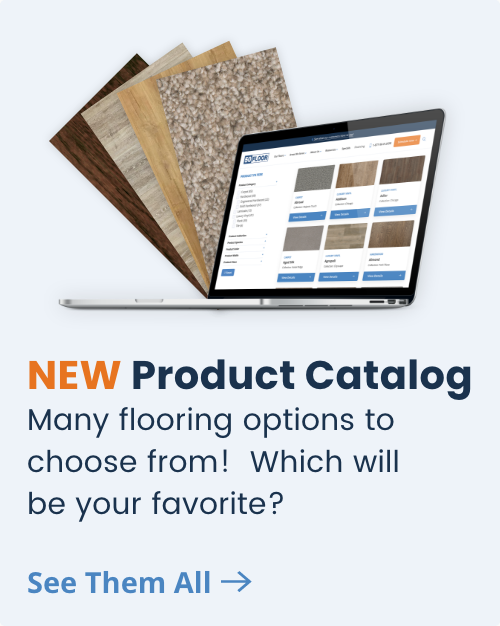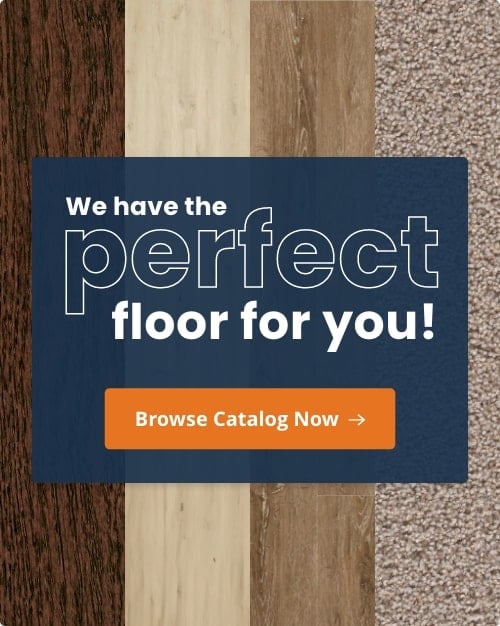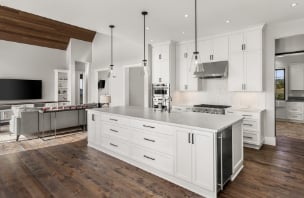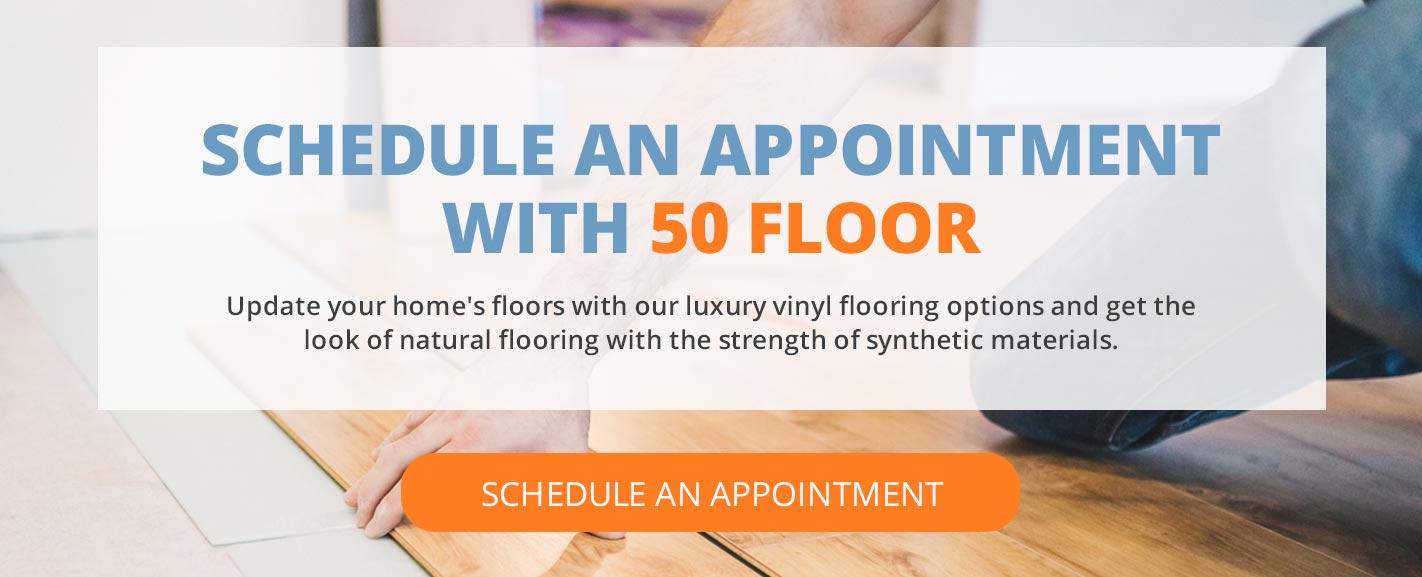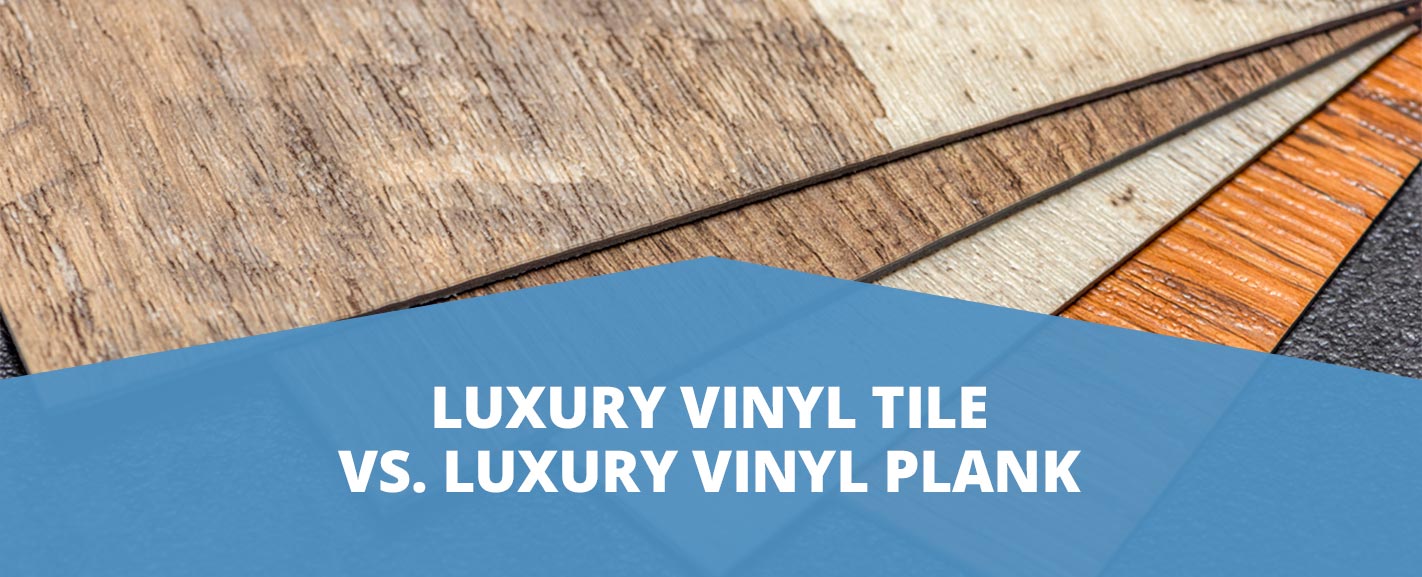

When looking for new flooring, choosing between all the available options can be challenging. Balancing your budget with benefits and different flooring features can make choosing a floor more stressful than necessary. You want your floors to be attractive, durable and cost-effective, and luxury vinyl meets all of these qualifications.
Luxury Vinyl Tile (LVT) and Luxury Vinyl Plank (LVP) are both types of luxury vinyl flooring. LVT comes in tile form, while LVP comes in flooring planks. Learn more about the similarities and differences between luxury vinyl tile and luxury vinyl plank in this article.
Choosing the right flooring style will give your home stylish, high-quality flooring for years to come and ensures a comfortable place for your family to live in. Explore the many benefits of luxury vinyl floors and find the best fit for your home today.
What Is Luxury Vinyl?
Luxury vinyl is a newer form of vinyl flooring. Luxury vinyl tile (LVT) and Luxury vinyl plank (LVP) are flooring options built from luxury vinyl materials. Luxury vinyl floors have multiple layers, which help create a thicker, damage-resistant base. You can customize your floor with several backing, design and texture options to perfectly complement your unique home and interior design.
New technology allows modern LVT and LVP to mimic the look of natural materials like wood, tile and stone in a wide variety of colors and patterns. Some luxury vinyl floors are even textured for a more realistic feel and appearance. Old vinyl flooring came in sheets, making it feel less high-quality than other floorings. Luxury vinyl comes in planks or tiles and can have seams for grout and wide or narrow planks for custom, natural-looking flooring.
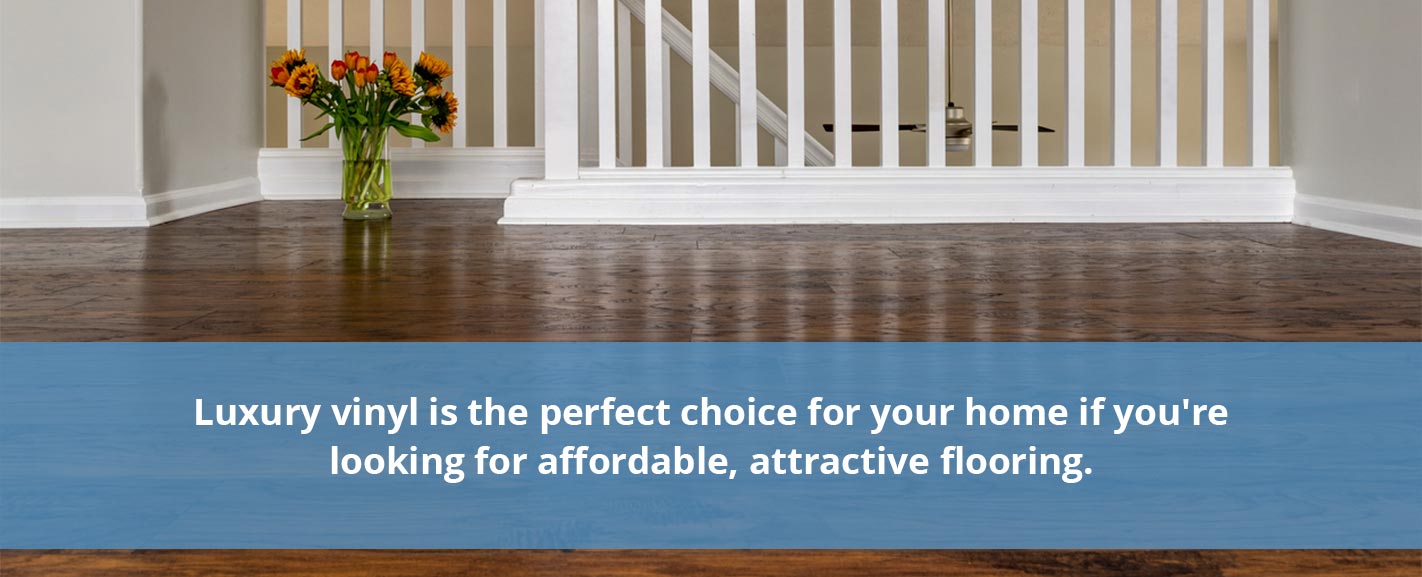

Similarities Between LVT vs. LVP
When deciding between LVP or LVT, consider how your floors look and which room they are located in. There are many benefits to luxury vinyl flooring, and comparing LVP vs. LVT flooring will help you make the best decision for your home. Luxury vinyl offers the look and feel of natural flooring, with increased durability, waterproofing, and style options. You’ll also achieve your dream flooring at a lower cost and with less maintenance than many other flooring materials.
For example, you might choose planks for your living room, bedrooms, and even kitchen to mimic the classic, stylish lines of wood flooring. For bathrooms and laundry rooms, vinyl tile may better fit each room’s traditional floor styles without giving up the technology of luxury vinyl.
To make the best choice, think about your project’s scope, personal style preferences, and budget considerations.
Key Questions to Consider:
- Project Scope: Are you renovating a cozy home nook or redesigning a bustling office space? The scale of your project can significantly influence your decision.
- Style Preferences: Do you lean towards the timeless elegance of stone or the warmth of wood? Your personal taste will play a crucial role in your selection.
- Budget Considerations: How does your budget align with your vision? Luxury vinyl options can offer the perfect blend of affordability and style.
By pondering these questions, you can chart a course to the flooring that not only meets your aesthetic and functional requirements but also brings you joy every day.
These two popular floor options have many similarities, including:
Cost
Luxury vinyl is the perfect choice for your home if you’re looking for affordable, attractive flooring. Luxury vinyl is a less-expensive alternative to traditional wood, stone or tile flooring. Since luxury vinyl is designed to mimic natural materials, you can select any color or design you want without worrying about the extra costs associated with exotic or higher-end materials. Exotic woods and luxury materials cost more to install, purchase and maintain than other materials, making it expensive to achieve your dream floor look.
With luxury vinyl, you can get any style at a more affordable price. Add embossed or textured features for a more realistic finish without paying for expensive materials. Even including stain-resistant layers will save you money on repairs and replacements in the future while remaining below the price point of many other designs.
Waterproofing
You want to avoid wear and damage to your floors, but water often causes warping, stains, mold and even rot for some types of flooring. LVT and LVP are both waterproof and built to withstand moisture without damage. Luxury vinyl is constructed from waterproof materials, which can be dried and reused, even after water immersion. Their water resistance makes them ideal for basements, bathrooms and kitchens.
Ease of Care
Natural floorings are attractive, but they often require special cleaning and care. Others, like carpets, attract dust and lint and need regular deep cleanings or replacements to remove dirt and allergens.
Luxury vinyl is made with easy-to-clean materials. Simply mopping and sweeping regularly will remove any debris without damaging the floor. Nonvinyl flooring may need special care or cleaning materials and can become damaged if you accidentally use the wrong cleaning method. Luxury vinyl will withstand scrubbing and washing easily, making cleaning a quicker and less stressful process for your home.
Durability
Without proper care, wood can warp, tile can crack and carpet can flatten. Luxury vinyl will withstand regular wear and tear for 25 to 30 years. When properly installed, vinyl is extremely durable and resistant to water, cracks, scratches and stains. Luxury vinyl options can come with a highly scratch-resistant layer, protecting the floor from gauges, scrapes and tears.
Luxury vinyl also resists cracking since its slight give provides flexibility and strength. It’s almost entirely sealed against water penetration, protecting your home from mildew and mold. Additionally, you can get stain-proof layers for your luxury vinyl floors, preventing surface scuffs and discoloration that may show up on traditional vinyl floors.
Differences Between LVT vs. LVP
While luxury vinyl options available are very similar, there is one main difference between luxury vinyl tile and luxury vinyl plank, and that difference is found in their names. LVT and LVP are made from the same material, but one comes in planks and the other in tiles. While both forms of luxury vinyl have the same benefits, choosing between tile and planks will probably depend on the room you plan to install them in.
While both flooring types offer the same waterproof, scratch-resistant benefits, you want to choose the style that complements your home. When weighing luxury vinyl tile vs. plank, select the type that best fits each room. For example, you might choose planks for your living room, bedrooms and even kitchen to mimic the classic, stylish lines of wood flooring. For bathrooms and laundry rooms, vinyl tile may better fit each room’s traditional floor styles without giving up the technology of luxury vinyl.
While form is the only real difference when choosing luxury vinyl plank vs. luxury vinyl tile, there are different installation options that work for both LVT and LVP. Floating-click vinyl tiles or planks click together and float above the subfloor. Glue-down installation involves taping or gluing the flooring directly onto the subfloor. Glue-down is not always as waterproof as floating-click, so keep this in mind when installing luxury vinyl in your home.
Schedule an Appointment With 50Floor
If you’re interested in installing hard flooring in your home, LVP or LVT offers the perfect combination of style and strength. Whether you choose tiles or planks, your home will have durable, easy maintenance flooring that looks great and withstands years of use. Enjoy the peace of mind of luxury vinyl and never worry about water damage, scratches or pet stains again.
Update your home’s floors with our luxury vinyl flooring options and get the look of natural flooring with the strength of synthetic materials. If you’re looking to install new flooring, contact us to schedule an appointment today. During a free in-home appointment, our flooring consultants will provide information about lvp vs lvt flooring and show you flooring samples in your home’s lighting and decor.
FAQs
Is LVP Flooring Suitable for High-Traffic Areas?
Absolutely, luxury vinyl plank (LVP) flooring is engineered to handle high-traffic areas exceptionally well. Whether it’s a bustling home or a busy commercial space, LVP is built to last.
Here are some reasons why LVP is an excellent choice for these demanding environments:
- Durability: LVP is crafted with multiple layers, including a tough wear layer that protects against scratches, dents, and stains. This makes it perfect for areas where foot traffic is heavy.
- Easy Maintenance: Cleaning LVP is a breeze. Its surface resists spills and dirt, making both daily upkeep and deep cleaning simple tasks.
- Comfort and Safety: Unlike harder flooring options, LVP offers a slight cushion underfoot, providing more comfort for prolonged standing or walking. Additionally, its slip-resistant surface adds an extra layer of safety, which is crucial for areas with a lot of movement.
- Water Resistance: Many LVP options are highly water-resistant or even waterproof, making them ideal for kitchens, bathrooms, and entryways where moisture is a concern.
- Aesthetic Flexibility: With a wide range of styles and finishes, LVP can mimic the look of wood, stone, or tile, offering high-end aesthetics without the high-end cost or upkeep.
Using LVP in high-traffic areas is not just a practical choice but also a stylish one. Its resilience and low maintenance make it a smart investment for any space that sees a lot of action.
Can LVP Flooring Be Installed Over Existing Flooring?
Yes, luxury vinyl plank (LVP) flooring can often be installed over existing flooring. This makes it an appealing option for many homeowners looking to update their spaces without the hassle of removing old flooring. However, there are several important factors to consider:
Condition of Existing Floor:
- Level: The subfloor must be even to ensure a smooth installation. Any bumps or dips can result in an uneven surface for your new LVP.
- Clean: Ensure the existing floor is free of debris, dust, and grime to allow the adhesive to bond properly.
- Good Condition: The current flooring should be in good shape. If it’s damaged or deteriorating, it might affect the installation and longevity of the LVP.
Types of Existing Flooring:
- Hardwood: LVP can usually be installed directly over hardwood, provided it’s in stable condition.
- Tile: Installing over tile is often possible, but make sure the grout lines are not too deep.
- Carpet: LVP should not be installed over carpet due to its softness and give.
What Are the Steps for a Successful Installation?
Preparation:
- Clean Thoroughly: Sweep and mop the existing floor to remove any contaminants.
- Level the Floor: Use a leveling compound or underlayment if necessary to achieve a flat surface.
Consultation:
- Seek Expert Advice: It’s always a good idea to consult with flooring professionals or specialists. They can provide tailored recommendations based on the specific conditions of your current flooring.
While installing LVP over existing flooring is convenient and potentially cost-effective, ensuring the proper conditions and preparation is critical for a successful and lasting installation. Always verify with experts if you have any doubts about the suitability of your current flooring as a subfloor.
